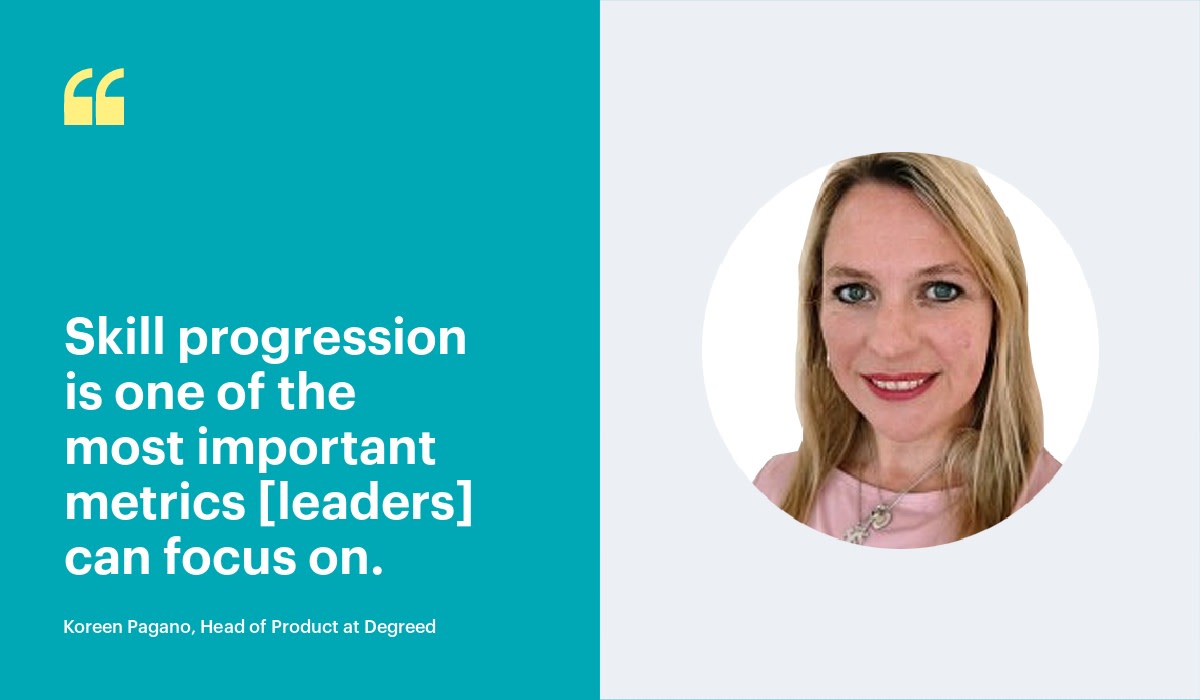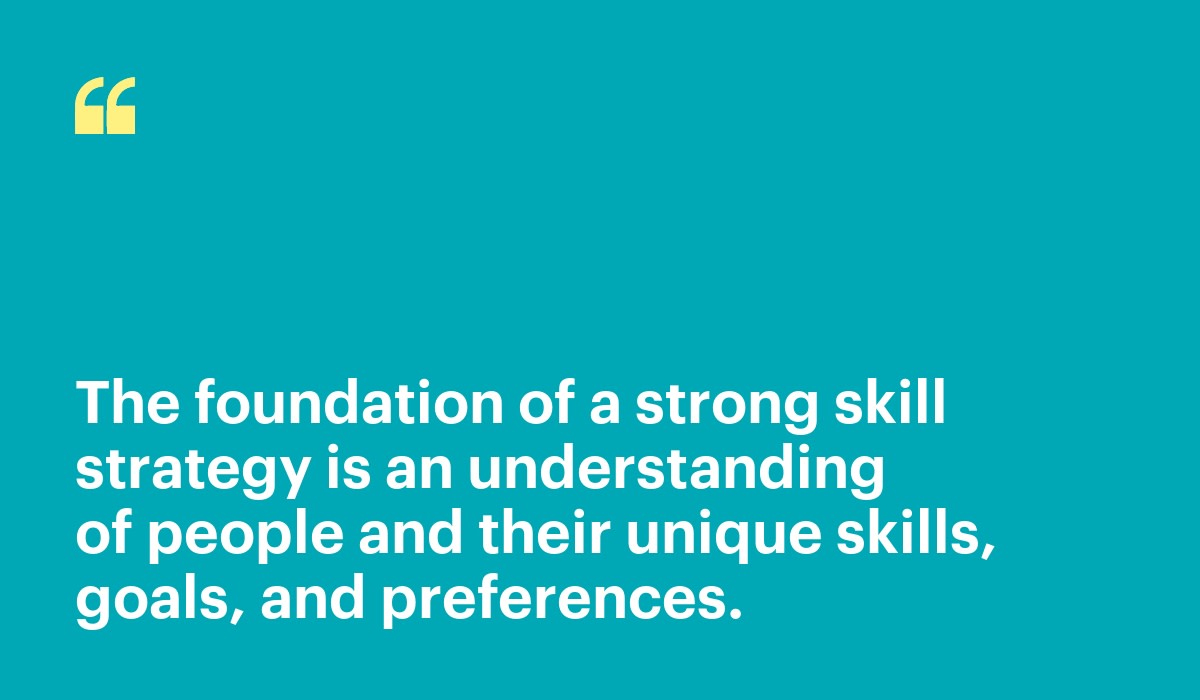Measuring Skills Data—Which Metrics Matter?
Organizations know what skills data is and why it matters, but actually measuring it isn’t simple because which skill metrics matter depends on who’s asking.

Understanding how we work is more crucial than ever. In the midst of lasting workforce changes spurred by COVID-19, organizations have faced tough decisions around restructuring, hiring or downsizing, and transitioning to and from remote or hybrid models. To make these decisions effectively, they needed hard data on their peoples’ talents and skills, but many hadn’t invested the time and resources to collect it.
As organizations try to catch up, conversation around skills data has reached a fever pitch. Though many organizations know what skills data is and why it matters, actually measuring it isn’t a simple prospect. Organizations need a clear plan for capturing it and an understanding of which metrics will actually support their goals.
So which metrics are the most helpful and impactful for companies looking to track skill data? The answer might be surprising. According to the experts at workforce upskilling platform Degreed, which skill metrics matter depends at least in part on who’s asking.
How to get skills data on the C-suite’s radar
According to Koreen Pagano, head of product at Degreed, those working at the executive leadership level, such as CHROs, will want to ensure that their peoples’ skills are continually improving. But beyond that, they need to know they’re doing so in alignment with company goals.
“Skill progression is one of the most important metrics [leaders] can focus on,” Koreen explained. But while progression is important for HR leaders to see that their reskilling and upskilling strategies are working, alignment helps them understand their organizational impact.
“You can have a highly engaged, learning workforce, but if they aren’t focused on skills that align with your business strategy, then their efforts won’t progress your organization,” Koreen continued. “Close strategic alignment makes it easier to justify future investments in learning and talent development, as well as talent acquisition.”

Skill data for learning and development
Learning and development managers are another group likely to be highly engaged with skill data. But they’ll use very different metrics than HR leaders to shape their strategy and evaluate their success.
“[Learning and development managers] want to ensure their people have the skills needed both now and in the future, and to build them in the most effective way,” said Todd Tauber, Degreed’s Senior Vice President of Strategy. “Two metrics support this: skill supply, or the skills we have to get critical work done, and skill demand, or the skills we need.”
These core metrics will help those building reskilling or upskilling strategies identify the gap between the skills they have and those they need, giving them clear objectives they can use to design learning plans and upskilling initiatives.
Then they can use supporting metrics to make those plans more effective. For example, that could include data on the topics and instruction styles their people prefer and information on individuals’ own interests and professional goals.
Balance organizational objectives with individual goals
While people will use varying metrics to work with skill data, they should always be guided by individual workers’ interests, passions, and goals. “Data on individual goals will help managers tailor learning opportunities to each individual,” explained Todd. “This makes it more likely that they will actually engage, improving learning ROI.”
After all, for all the planning that goes into creating upskilling initiatives, individual employees will be doing the actual work of gaining these new skills. If doing so doesn’t benefit them as well as their organizations, reskilling and upskilling initiatives will be unlikely to find success. “People will only dedicate the time and effort to upskilling if they see what’s in it for them,” said Koreen. “That could be doing their current role better or shifting to a new business area entirely.”
To build effective skill, learning, and professional development strategies, organizations need data on not only the skills their people have, but also the ones they want. Then they can identify the overlap between the skills their people want and the ones their organization needs to acquire.
No skills without people
No matter the skills metrics tracked, they must be individualized to actual people. That’s where people analytics comes in—giving context to skill data and placing it within an overall picture of an organization’s people.
By combining skills data with the deep, specific knowledge of their workforce offered by people analytics, leaders can take strategic, targeted actions like measuring turnover by skills or identifying which skill sets are predominant in certain areas of their organization.
“People analytics makes skills data actionable and relevant to individuals,” said Janice Burns, Chief Career Experience Officer at Degreed. “You need everyone to feel engaged and excited about their learning opportunities. You can only do this if the learning is tailored to each individual.”
“HRIS and skills data combined will ultimately improve the way organizations manage and develop their talent,” agreed Todd. “It can remove bias from talent decisions, and it provides the oversight needed to optimize talent spend across the whole acquisition, development, and management cycle.”

Skill data for sustainable growth
Skills data is complex and multidimensional—a fact Janice likes to drive home by comparing it to health and medical data. “Similarly to skill data, there’s a wealth of ways to collect health data, from medical sources to wearables,” she explained. “When choosing your metrics for health data, you’d likely start from what you want to achieve.”
That same approach should be used to guide organizations that are looking to get started with skill data. Different levels of an organization will have different needs and objectives when gathering skill data and will not measure it in a uniform way.
Metrics such as alignment, progression, and skill supply will have varying significance to people working in different roles. But no matter what, the foundation of a strong skill strategy is an understanding of people and their unique skills, goals, and preferences. With people analytics, organizations can bring these two levels of understanding together.

On the Outsmart blog, we write about workforce-related topics like what makes a good manager, how to reduce employee turnover, and reskilling employees. We also report on trending topics like ESG and EU CSRD requirements and preparing for a recession, and advise on HR best practices how to create a strategic compensation strategy, metrics every CHRO should track, and connecting people data to business data. But if you really want to know the bread and butter of Visier, read our post about the benefits of people analytics.
Get Outsmart content straight to your inbox
Subscribe to the People Insights Monthly newsletter for actionable insights and stories.
Subscribe now